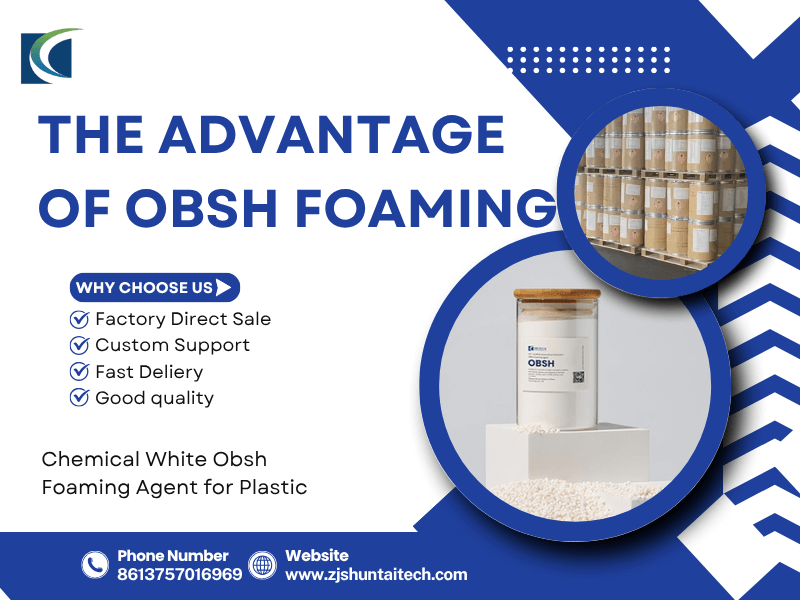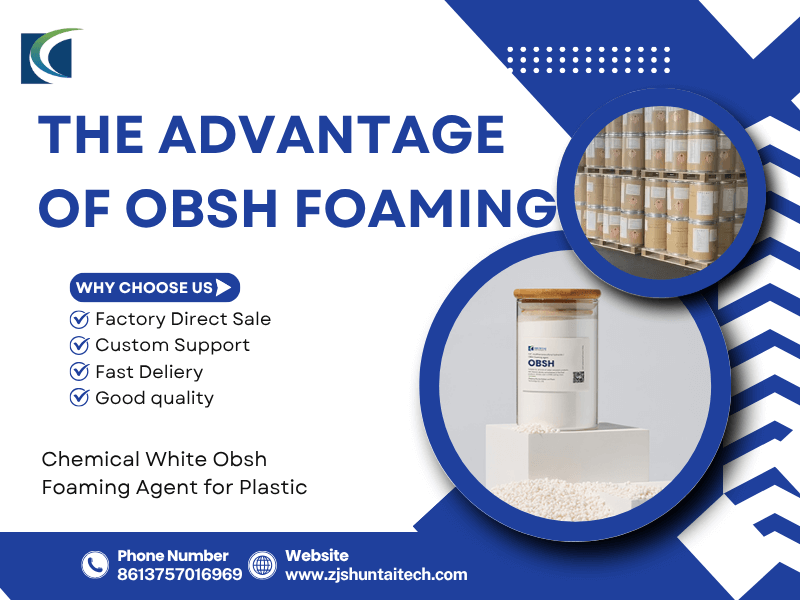In modern industrial production, blowing agents play a pivotal role, breathing new life into materials and giving products unique properties and structures. Among the many foaming agents, OBSH blowing agents stand out for their excellent properties and are preferred by many industries.
OBSH blowing agent, chemically known as 4,4'-oxobiphenylsulfonylhydrazine, has the chemical formula C₁₂H₁₄N₄O₅S₂, and the sulfonylhydrazine group contained in the molecular structure is the key to its foaming effect. In appearance, the OBSH blowing agent appears as a white powder, giving a sense of purity. It has a melting point of 150 - 165°C and a density of about 1.52g/cm³, which is excellent in terms of thermal stability. In terms of solubility, it is slightly soluble in hot water and ethanol, but insoluble in cold water and in most organic solvents, a property that enables it to perform precisely in different production environments and material systems.
In terms of synthesis methods, there are two main common routes for OBSH blowing agents. One is the chlorosulfonation route, in which diphenyl ether is used as the starting material and reacted with chlorosulfonic acid to form 4,4'-oxo-diphenylsulfonyl chloride, which is then reacted with hydrazine hydrate to obtain 4,4'-oxo-diphenylsulfonyl hydrazide. In another approach, diphenyl ether is first sulfonated with concentrated sulfuric acid and then reacted with phosphorous trichloride to form 4,4'-oxydiphenylsulfonyl chloride, which is then reacted with hydrazine hydrate and ammonia to form the target product . Although these two synthesis paths are complex, it is the precise control of the reaction conditions that ensures the stable and high quality performance of the OBSH blowing agent.

High Quality Bubble Structure
When the OBSH blowing agent decomposes within a certain temperature range, nitrogen is released. During this process, it induces the formation of an extremely fine, uniform and dense pore structure in the product. This high-quality pore structure is significant in the production of many products. Taking rubber products as an example, the fine and uniform bubble holes can greatly enhance the elasticity of rubber, so that it can be quickly restored to its original state after being extruded by external forces; at the same time, it enhances the abrasion resistance of rubber and prolongs the service life of the product. In terms of plastic products, this kind of bubble structure can make the appearance of plastic products more fine and better texture, which can satisfy the consumers' pursuit of high quality product appearance.
Suitable Decomposition Temperature
The decomposition temperature of OBSH blowing agents is relatively centralized, generally in the range of 130 - 160°C. This temperature range is very high in plastics and rubber processing. This temperature range offers unique advantages in the processing of plastics and rubber. In plastics processing, many plastic materials maintain good fluidity and plasticity in this temperature range, and OBSH blowing agent decomposes and foams at this temperature, which is a perfect match for plastics processing and enables accurate foaming. For rubber processing, this temperature range is also in the appropriate temperature range for vulcanization of most rubbers, and there is no need to add additional decomposition additives to promote decomposition of the blowing agent, which simplifies the production process, reduces the cost and complexity of the process, and improves the production efficiency.
Environmentally Friendly and Non-Toxic
The environmentally friendly and non-toxic nature of OBSH blowing agent is of particular importance in a time of increasing environmental awareness. It is free from formamide and other carcinogens and does not cause environmental pollution or health hazards to operators during production and use. This makes it useful in many areas where safety and environmental protection are of paramount importance. In the production of food packaging materials, OBSH blowing agent ensures that the packaging materials do not cause any contamination of food, thus guaranteeing food safety. In the field of medical supplies, its non-toxic properties allow it to be used in the manufacture of medical product components that come into contact with the human body, providing strong support for the safe development of the medical industry, in line with the current global trend of green development.
Wide applicability
OBSH blowing agent is a “multi-faceted player” in industrial production, with extremely wide applicability. In the rubber industry, it is applicable to natural rubber as well as various synthetic rubbers such as EPDM, SBR, CR, FKM, IIR, NBR, etc . In these rubber materials, OBSH blowing agents can be evenly dispersed and work effectively to give unique properties to rubber products. In the plastics industry, OBSH blowing agent also excels in the production of thermoplastic products such as polyvinyl chloride (PVC), polyethylene (PE), polystyrene (PS), and acrylonitrile-butadiene-styrene copolymer (ABS). OBSH is also capable of providing good foaming effects in complex systems such as rubber-resin blends and rubber-plastic blends, which meets the needs of different industries for diversified material properties.
Good Electrical Insulation
OBSH blowing agent shows significant advantages in areas such as wire and cable manufacturing, where the requirements for electrical insulation properties are very demanding. When used in wire and cable insulation, the foamed structure does not negatively affect the electrical insulation properties of the product, but rather reduces the weight of the insulation layer to a certain extent and improves the flexibility of the wire and cable. In the case of high voltage cables, which are required to transmit power over long distances, the use of OBSH blowing agent ensures the safety and stability of power transmission while reducing the overall weight of the cable, making the laying process more difficult and less costly.
Multifunctional properties
In specific curing mechanisms, OBSH blowing agents show surprising multifunctional properties, acting both as blowing agents to generate air bubbles and as cross-linking agents to promote cross-linking reactions in the material. In the production of some rubber products, while OBSH blowing agent decomposes and generates bubbles to make rubber foam, certain groups in its molecular structure can cross-link with rubber molecules to form a more stable network structure. This multifunctionality greatly simplifies the production process. Where two different additives, a foaming agent and a cross-linking agent, may have been required, only the OBSH blowing agent is now required, reducing production costs and improving the overall performance of the product by optimizing the product's microstructure.

Rubber Industry
In the rubber industry, OBSH blowing agents are widely used. In the manufacture of shoe soles, the use of OBSH blowing agent can make the soles have good softness and elasticity, more comfortable to wear, and at the same time improve the abrasion resistance of the soles and prolong the service life. Taking the soles of sports shoes as an example, the uniform bubble structure produced by OBSH blowing agent enables the soles to provide good cushioning performance while effectively dispersing the pressure on the feet and reducing the impact of sports on the feet. In the production of seals, the addition of OBSH blowing agent makes the seals have better sealing and flexibility, and can adapt to the pressure and temperature changes in different working environments to ensure the sealing effect, which is widely used in the sealing of automobile, machinery and other industries.
Plastic Industry
In the plastic industry, OBSH blowing agents play an important role in the production of plastic sheets, pipes, foam and other products. In the production of plastic plates, OBSH blowing agent can make the plates form a uniform foam structure, reduce the weight of the plates and at the same time, improve the heat insulation and sound insulation properties of the plates, so that they are widely used in construction, furniture and other fields. In foam production, OBSH blowing agent can accurately control the size and density of the bubble holes to produce foam products with different specifications and properties, which are used in packaging, thermal insulation and other industries. For packaging of electronic products, foam produced with OBSH blowing agent can provide good cushioning protection and is in line with the current trend of green packaging due to its environmentally friendly properties.
Wire and cable industry
As mentioned earlier, OBSH blowing agent is mainly used in the wire and cable industry for insulation manufacturing. With the continuous development of communication technology and electric power industry, the performance requirements of wires and cables are getting higher and higher, and the insulation layer made of OBSH blowing agent not only has good electrical insulation performance, but also improves the flexibility and bending resistance of cables, which meets the complex installation requirements of cables in modern wiring projects. In some high-speed communication cables, the application of OBSH foaming agent can effectively reduce the loss during signal transmission and improve the quality of communication.
Other Fields
In addition to the major industries mentioned above, OBSH blowing agent in the field of leather foaming can make the leather have a softer handfeel and unique appearance and texture, and improve the quality of leather products. In the manufacture of products such as stroller guards and handles for sports equipment, OBSH foaming agent provides good non-slip performance and comfortable grip. In the manufacture of heat insulation pipes, its foaming structure can effectively improve the heat insulation performance of heat insulation pipes and reduce heat transfer, which is widely used in the fields of building heating and chemical pipeline insulation.
Comparison with other common blowing agents
AC blowing agent, chemically known as azodicarbonamide, is a commonly used blowing agent. In terms of decomposition temperature, AC blowing agents have a wide range of decomposition temperatures, generally in the range of 160 - 220°C, whereas the decomposition temperature of OBSH blowing agents is comparatively lower and is concentrated in the range of 130 - 160°C. This makes OBSH blowing agents more suitable for use in temperature-sensitive production processes. This gives the OBSH blowing agent an advantage in temperature-sensitive production processes, enabling more precise control of foaming time and effect. In terms of outgassing volume, the outgassing volume of OBSH blowing agent is about 120 - 130 ml/g, whereas the outgassing volume of AC blowing agent is relatively higher, but OBSH blowing agent forms a more fine and uniform pore structure. In terms of environmental performance, OBSH blowing agent is free from formamide and carcinogens, and its environmental performance is better than that of AC blowing agent, and OBSH blowing agent is preferred in the field of strict environmental protection requirements.
Comparison with other sulfonylhydrazine blowing agents
Among the family of sulfonyl hydrazine blowing agents, OBSH blowing agent stands out for its wide applicability. Compared to some other sulfonylhydrazine blowing agents, OBSH blowing agents not only perform well in common rubber and plastic materials, but also exhibit stable foaming performance in complex rubber-plastic compounding systems. In terms of electrical insulation properties, OBSH blowing agents have a clear advantage in applications such as wires and cables, where insulation requirements are high, and some of the other foaming agents in the same category are difficult to match. In terms of cost, although the production cost of OBSH blowing agent is relatively high, its comprehensive performance advantages make it cost-effective and competitive in a wide range of high-end products and in areas with stringent performance requirements.
Conclusion
OBSH blowing agent occupies an important position in many industrial fields such as rubber, plastics, wire and cable by virtue of its advantages such as high-quality bubble structure, suitable decomposition temperature, environmental protection, non-toxicity, wide applicability, good electrical insulation and multifunctional properties. Although it has some minor shortcomings such as higher cost, these problems are expected to be gradually improved with the continuous progress of technology and optimization of production process. Compared with other common blowing agents, OBSH blowing agent's unique advantages in performance make it an ideal choice for many industries in pursuit of high-quality products and green production. In the future, as industrial technology continues to innovate and the requirements of various industries for material performance continue to improve, OBSH blowing agent will certainly usher in a broader space for development and contribute more to the progress of industrial production.

